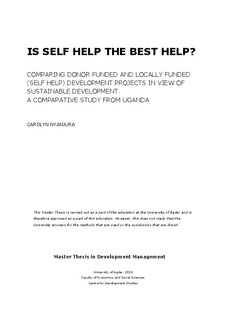| dc.description.abstract | Persistent poverty in low developed countries is a concern which has drawn a number of
external efforts, the most recent being the Millennium Development Goals (MDGs). The
paradox has and still is that while aid has been provided in large quantities, the debt burden
and poverty levels in developing countries, especially Sub Saharan Africa, seem to be on the
increase and the ability of aid to solve this is highly questioned (Erixon, 2005; Watkins, 1995
This state of affairs propelled this study to investigate the option of development from withinself
help. Using a comparative approach to the study, self help projects and donor funded
projects were looked at. The purpose was to establish to which degree sources of funding
have an impact on the sustainability of development projects, measured as improved and
environmentally friendly livelihoods for local people.
Specifically, the study assessed the formation and management of both donor funded and self
help projects. It also went ahead to assess how the difference in formation and management of
the two categories of projects influences realisation of improved and environmentally friendly
livelihoods. This study reports on an investigation of five different cases of both donor funded
and self help projects in Jinja district, Uganda. These cases were studied using a qualitative
strategy because of interest in an in-depth understanding of people‟s views about the donor
and self help projects. This was achieved through conducting of unstructured interviews,
accompanied by focus group discussions (FGDs), participant observation and content analysis
of relevant documents.
Principal conclusions from this study include;
Both donors funded and self help projects cannot be guaranteed to result into sustainable
development unless it is purposed. With predetermination, donor funded projects are more
likely to implement the notion of environmentally friendly livelihoods although not
necessarily improved livelihoods for the people.
Self help projects have higher chances of realising improved livelihoods in developing
countries compared to donor funded projects, although they are less likely to put the
environment into consideration.
Basic skills of managing and running a project are important for the success of both donor and
self help projects.
From the findings and analysis, conclusions and recommendations for future practice were
made and include:
Channelling of development aid to capacity building of communities in the area of
financial management, attitude change and environmentally friendly practices.
Using micro loans through organised groups as the strategy for development in the
developing countries.
Making environmentally friendly practices a requirement for any development pursued
by any party whether the community or donors.
Making individual decision about livelihoods a priority if improved livelihoods are to
be realised. | en_US |
